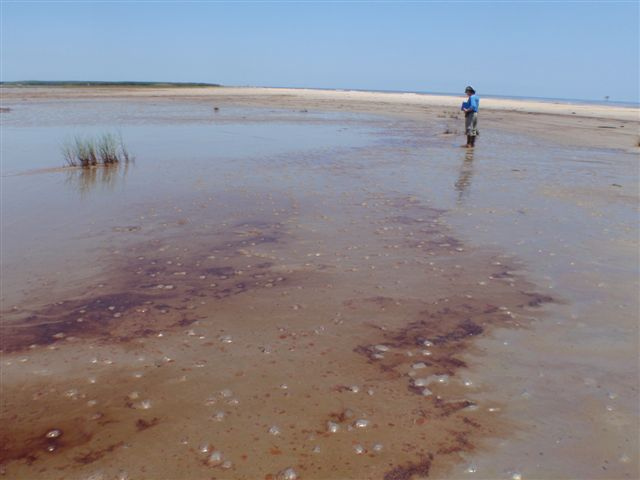Tar Washing Ashore Shows Gulf Coast Not Back to Normal (Op-Ed)


Chase Martin is a media relations intern for U.S. Campaigns at Oceana. This Op-Ed was adapted from one that appeared on Oceana's blog, The Beacon. Martin contributed this article to Live Science's Expert Voices: Op-Ed & Insights.
Florida's Gulf Coast is renowned for its soft white beaches, balmy weather, and calm, clear waters. It's also infamous for being a mecca of debris from oil-rig related tragedies, which until recently, were thought to have mostly finished their attack on Gulf-Coast beaches. But even after four years, trash from the Deepwater Horizon oil disaster is still washing ashore and devastating coastal environments and communities.
In February, a group from the Florida State Department of Environmental Protection discovered an 81-square-foot tar mat cruising the shallows off Pensacola beach. That's 1,250 pounds of oily garbage that slithered across almost 200 miles of seabed, damaging environments and amassing sand and marine fragments.
This is only a tiny fraction of the 200 million gallons of oil that spewed into the ocean during the 2010 oil spill, devastating ecosystems throughout the Gulf and blackening the many coastal communities that rely on these waters for their livelihood. Over 1,000 miles of beaches and wetlands were oiled. Thousands of people suffered at the expense of this avoidable tragedy. Hundreds of thousands of animals perished, including marine mammals, fish stocks, seabirds and sea turtles.
Today, scientists can still see effects of the oil spill on marine ecosystems and seemingly healthy marine life, such as heart defects in tuna and amberjack. And what's more, Florida recently filed a lawsuit with BP over damages to the state's natural resources. Along with a past economic lawsuit and $26 billion in Gulf restoration, BP certainly has had to own up for the environmental and human health disaster and will continue to do so: The claim holds BP responsible and liable for past and future costs concerning resources and cleanup. Perfect timing for that tar mat to set an example. [Dolphins Seen Swimming in 2010 Gulf Coast Oil Spill (Video)]
Luckily, some areas are recovering, but this does not mean the disaster is over. Policymakers, especially many powerful officials in Washington, D.C., are inclined to believe the Gulf has fully recovered and things are more or less back to "normal." But with tar mats still surfacing, we are awaiting the day the Gulf shines to its past glory. Beaches are no longer black, but the less-obvious environmental complications are still present.
And with the BP disaster still rearing its oily head, the nation could soon be faced with similar disasters. Recently, the Bureau of Ocean Energy Management released a final proposal to allow controversial seismic airgun blasting for locating oil and gas deposits off the Atlantic coast. The method uses extremely loud blasts of compressed air to test for oil and gas deposits under the seafloor. These blasts could injure or kill thousands of marine mammals.
Get the world’s most fascinating discoveries delivered straight to your inbox.
One catastrophe on the scale of the BP disaster is one too many, but the United States has already had 12 other, lesser-known, spills since that time. Oil and gas drilling is moving forward in the Atlantic, and the nation could easily have another explosion on its hand within the coming years, with more beaches, more marine life and more hardworking Americans at peril. And, the U.S. government plans to allow seismic testing along the eastern seaboard, in an area twice the size of California, putting thousands of miles of coastline in jeopardy from the testing, and potentially from drilling. Jeopardy that is, frankly, extremely unnecessary.
The answer is simple: Don't drill. Invest in cleaner, greener energy solutions like offshore wind (which has the potential to provide three times as much power as oil and gas, and provide countless job opportunities). Officials need to consider the BP explosion not merely as an unfortunate accident, but as a reminder and a lesson learned.
Fortunately, Florida officials were able to clear most of the tar mat, but experts estimate that countless pounds of hazardous material are still poisoning the Gulf. For every tar mat we find on our coasts, there are countless others floating unnoticed in the ocean. Four years clearly has not been long enough to correct one mistake, and yet the administration of U.S. President Barack Obama continues the permitting process to open up the Atlantic Ocean.
You can take action and oppose drilling in the Atlantic by signing our petition learning more about the recent seismic testing report.
This Op-Ed was adapted from the post "Four Years Later, BP Oil Spill Still Rearing its Oily Head" in Florida on the Oceana blog The Beacon. Follow all of the Expert Voices issues and debates — and become part of the discussion — on Facebook, Twitter and Google+. The views expressed are those of the author and do not necessarily reflect the views of the publisher. This version of the article was originally published on Live Science.


